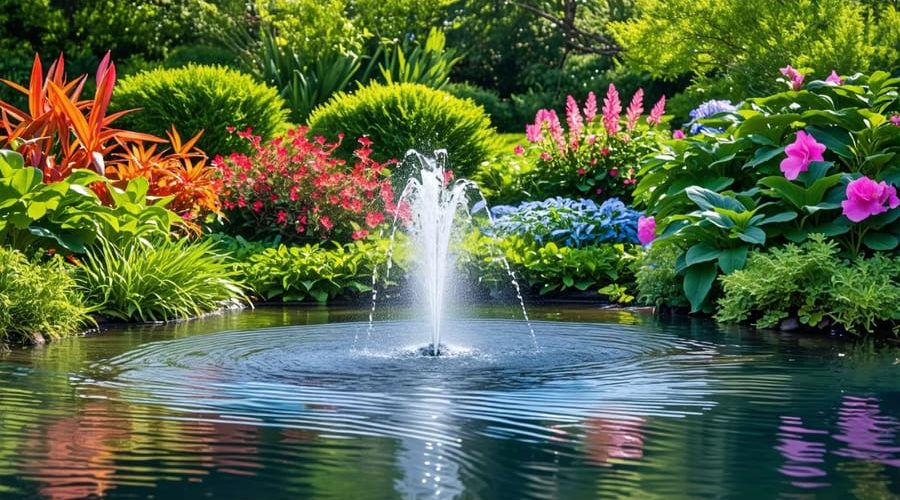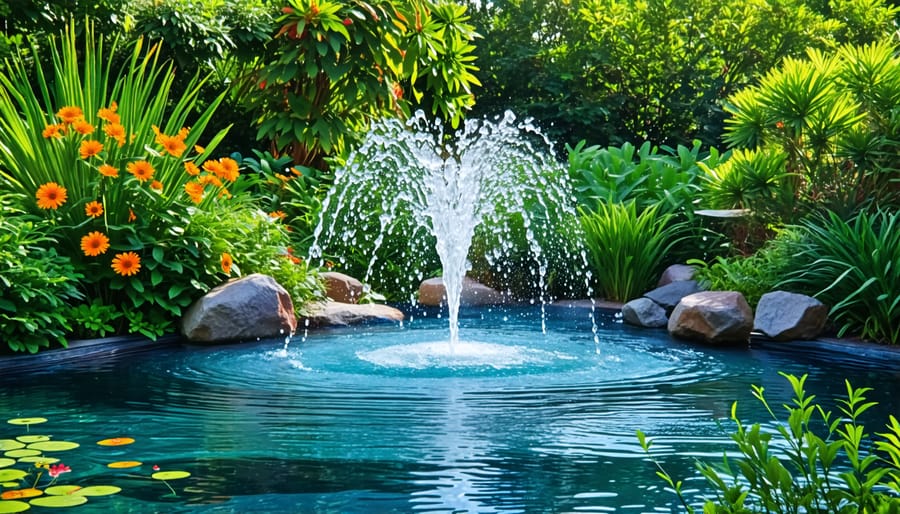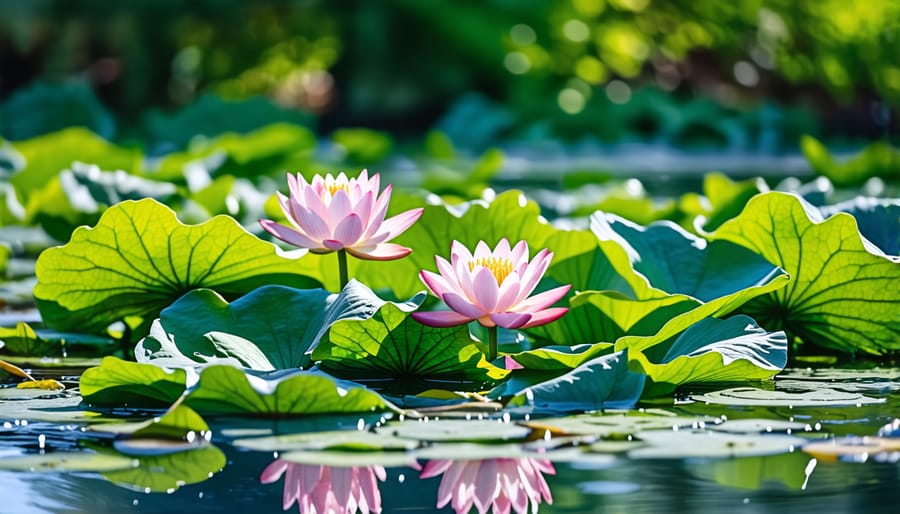
Natural Pond Aeration: Breathe New Life into Your Water Garden
Install floating fountains or aerators to circulate oxygen-rich surface water and promote beneficial bacteria growth. Learn how to make your own DIY pond aerator.
Introduce submerged plants like hornwort, fanwort, and anacharis that release oxygen underwater through photosynthesis. Discover the top oxygenating plants for your pond.
Create ripples and water movement using waterfalls, streams, or fountains to increase surface agitation and natural oxygen exchange.
Maintain proper water depth (at least 18 inches) to support a healthy temperature gradient and sustain oxygenating aquatic plants. Find out the ideal depth for your pond size.
Natural Pond Aeration Techniques
Fountain Aeration
Fountain aeration is a natural and visually appealing way to keep your pond healthy and well-oxygenated. By installing a fountain, you can create a stunning centerpiece for your water garden while promoting beneficial water circulation and aeration. As water is propelled into the air by the fountain, it breaks into countless droplets, increasing the surface area exposed to the atmosphere. This process allows for efficient gas exchange, enabling oxygen to dissolve into the water while releasing harmful gases like carbon dioxide.
When selecting a fountain for your pond, consider factors such as pond size, water depth, and desired aesthetic. Opt for a fountain that complements your pond’s overall design and provides sufficient aeration based on its specifications. Installation typically involves placing the fountain in the center of your pond, ensuring it is level and securely anchored. Connect the fountain to a power source, following the manufacturer’s instructions and safety guidelines.
To maintain optimal performance and prevent clogging, regularly clean your fountain’s nozzles and filters. Remove any debris, such as leaves or algae, that may accumulate over time. Periodically inspect the fountain’s components for signs of wear and tear, replacing parts as needed. During winter months, consider removing the fountain to prevent damage from freezing temperatures.
By incorporating fountain aeration into your pond management strategy, you can create a thriving ecosystem that supports healthy fish, plants, and beneficial bacteria. When combined with other natural pond care techniques, such as natural filtration, fountains contribute to a balanced and self-sustaining water garden that you can enjoy for years to come.
Waterfall Aeration
Waterfalls not only add visual interest and soothing sounds to your pond, but they also play a crucial role in natural aeration. As water cascades down the waterfall, it breaks the surface tension and incorporates oxygen into the pond. This process helps maintain a healthy balance of dissolved oxygen, which is essential for fish, plants, and beneficial bacteria.
When designing your waterfall, consider the size and depth of your pond. A general rule of thumb is to have one inch of waterfall width for every 100 gallons of pond water. This ensures sufficient aeration without overwhelming the ecosystem. The height of the waterfall also affects aeration; a taller waterfall will create more turbulence and oxygen incorporation.
To construct your waterfall, start by selecting a location that allows for proper water circulation. Use rocks and boulders to create a natural-looking cascade, ensuring stability and preventing leaks. Install a pond liner and a waterfall spillway to direct the water flow. You can also incorporate plants around the waterfall to enhance its beauty and provide additional filtration.
Maintain your waterfall by regularly cleaning the pump and checking for any obstructions or leaks. Adjust the water flow as needed to optimize aeration and create the desired visual and auditory effects.
With a well-designed waterfall, you can enjoy the tranquil ambiance while providing your pond with the vital oxygen it needs to thrive. Experiment with different configurations and rock placements to create a unique and stunning water feature that enhances both the aesthetics and health of your pond.

Aquatic Plants for Aeration
Aquatic plants play a vital role in natural pond aeration by absorbing carbon dioxide and releasing oxygen through photosynthesis. As they grow, these plants also help to filter the water and provide habitats for beneficial bacteria that break down organic matter. When selecting aquatic plants for your pond, consider species that are well-suited to your climate and pond conditions.
Some excellent options for aeration include submerged plants like hornwort, anacharis, and cabomba, which are known for their oxygen-producing capabilities. Floating plants such as water lettuce and water hyacinth also contribute to aeration while providing shade and reducing algae growth. For those with shallow pond margins, emergent plants like cattails, rushes, and sedges are fantastic choices that help to stabilize the soil and filter the water.
When incorporating aquatic plants into your pond, aim for a mix of submerged, floating, and emergent species to create a diverse ecosystem. Be mindful not to overcrowd the pond, as this can lead to competition for resources and reduced aeration. Regular maintenance, such as removing dead or dying plant matter, will help to keep your pond healthy and well-oxygenated.
By strategically selecting and managing aquatic plants, you can harness the power of nature to create a beautiful and thriving pond environment that benefits from natural aeration. Experiment with different combinations and observe how your pond responds to find the perfect balance for your unique water garden.

Implementing Natural Aeration in Your Pond
Assessing Your Pond’s Aeration Needs
To assess your pond’s aeration needs, consider its size, depth, and the number of fish and plants it supports. A general rule of thumb is to provide 1 to 2 watts of aeration per 1,000 gallons of water. However, factors such as climate, pond shape, and water quality can influence aeration requirements.
Observe your pond closely for signs of poor aeration, such as stagnant water, foul odors, or fish gasping at the surface. If you notice any of these indicators, your pond likely needs more oxygen. Consult with local pond experts or use online calculators to determine the appropriate aeration system for your specific pond size and ecosystem.
Remember, the goal is to maintain a balanced, healthy environment for your pond’s inhabitants. By accurately assessing your pond’s aeration needs and implementing the right natural aeration techniques, you can create a thriving, vibrant ecosystem that brings joy to your outdoor space.
Choosing the Right Aeration Method
When choosing the right natural aeration method for your pond, consider the size and depth of your water feature, as well as your personal preferences and available resources. For smaller ponds, floating plants like water lilies and lotus can provide sufficient aeration through their natural processes. If you have a larger pond or desire more oxygenation, a fountain or waterfall can be an attractive and effective option. The movement of water from these features enhances aeration and creates a captivating focal point in your garden.
For those who prefer a more subtle approach, submerged plants like hornwort and anacharis can efficiently oxygenate the water without drawing too much attention. These plants also provide valuable habitat for fish and other aquatic life. If you have a deeper pond or want to ensure adequate aeration at all depths, consider installing a bottom-based aeration system using air stones or diffusers. This method allows for a more even distribution of oxygen throughout the water column.
Ultimately, the best natural aeration method for your pond will depend on your specific needs and preferences. Experimenting with different techniques and observing the results can help you find the perfect balance for your unique water garden.
Maintenance and Troubleshooting
To maintain a naturally aerated pond, regularly remove debris and excess vegetation that can impede water flow and oxygenation. Monitor water levels and top off as needed to ensure adequate circulation. Inspect and clean any pond pumps or filters according to the manufacturer’s guidelines. If you notice signs of poor aeration, such as fish gasping at the surface or foul odors, consider adding more aquatic plants or adjusting the placement of water features. In case of algal blooms or other water quality issues, consult our maintenance tips for guidance on restoring balance to your pond ecosystem. Remember, patience and consistency are key when it comes to maintaining a naturally aerated pond. With regular upkeep and attention to detail, you can enjoy a beautiful and healthy water garden for years to come.
